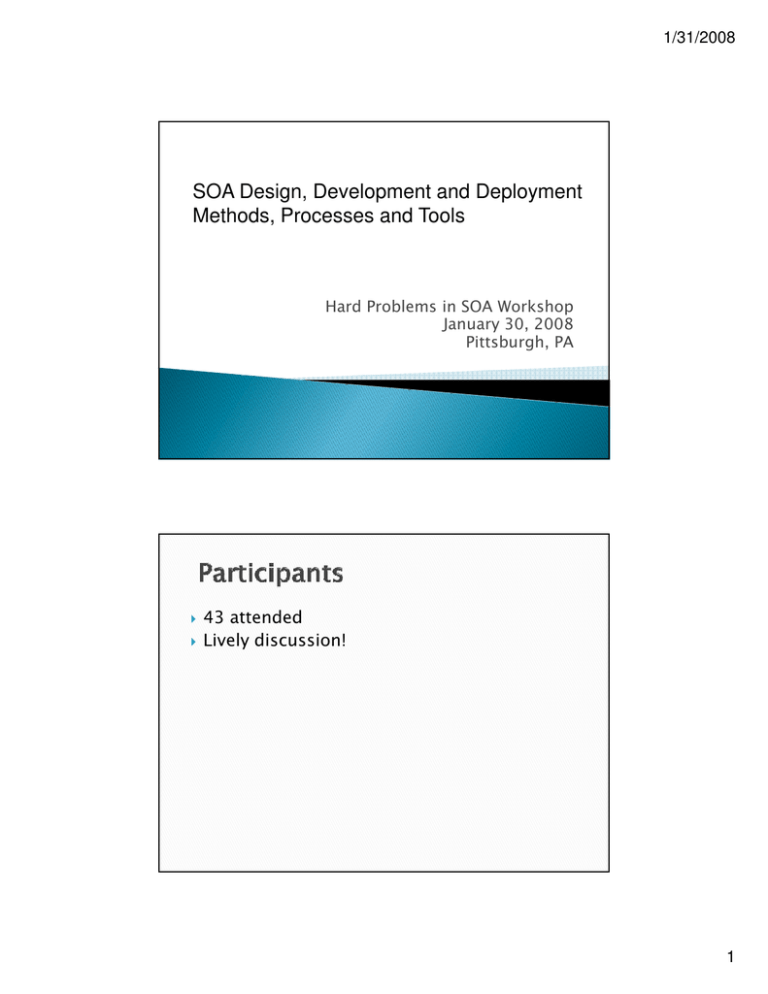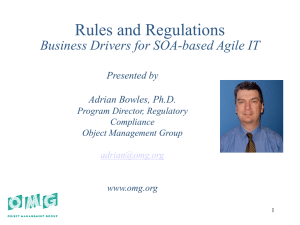SOA Design, Development and Deployment Methods, Processes and Tools 43 attended Lively discussion!
advertisement

1/31/2008 SOA Design, Development and Deployment Methods, Processes and Tools Hard Problems in SOA Workshop January 30, 2008 Pittsburgh, PA 43 attended Lively discussion! 1 1/31/2008 Methodology for system lifecycle with high rate of change and complexity ◦ How to understand business process and strategic intent ◦ How to design, build, test, deploy in that world ◦ How to discover reusable services, how to customize to instance of need, what is deployment architecture How to understand and evaluate an Architecture ◦ What are attributes that are most important, and particular in a SOA environment ◦ Way to model and measure agility, rate of change, resiliency of architecture, ability to evolve ◦ What are the generations of the architecture Assessment ◦ Assurance, testing and problem determination ◦ Suggestion: Build a maturity model (should be able to assess ourselves) Rapid evolution of requirements Switch to focus on connecting components vs building single system Enabling decision making Prescribed methodology will help interoperability Shared & 3rd-party provided vs owned components Evolution of services in parallel with evolution of application using the services Separation of producer and consumer of services, need for “contract” 2 1/31/2008 BPMN Agile development SOMA Ad-hoc assessments of legacy transformation SCA Formal analysis of BPEL models (Kramer, Magee) SEI – Smart legacy transformation OWL-S Methodology that bridges between business requirements, service and system design, and deployment architectures ◦ Closer integration of business analysts with IT architects – using common methods, conceptual models and formalisms ◦ Ability to model and simulate third party service levels to assess overall behavior Regulatory compliance issues ◦ SOA methodology needs to evolve to address compliance issues while maintaining agility and speed ◦ Across global set of regulations Asset management and reuse ◦ ◦ ◦ ◦ ◦ Versioning and compatibility Platform dependencies Customization and configurability of assets Change impact analysis Methodology to modularize and SOA-enable legacy components Defining the details of the “contract”, SLA, specifications ◦ How do you specify the service and service level you are providing? ◦ What about open-source, 3rd party services? 3 1/31/2008 Explore new methods and formalisms to better bridge business analysis with SW architecture Study effectiveness of different methodologies for rapidly evolving systems under set of regulatory constraints Address need for management of changes and versions at many levels of abstraction Investigate formalism for specification of Services and Service Level Define a common terminology for service repository accessible at design and run time Need to communicate clearly to identify and manage value and risk across an organization ◦ Exacerbated by distributed ownership of components ◦ Additional integration complexity ◦ Much more emphasis on interfaces Need for interoperability, reuse ◦ Avoid building SOA silos and duplicate efforts Need to measure agility, rate of change, resiliency of architecture, ability to evolve Frequent change of platforms and protocols 4 1/31/2008 SCA and SDO DODAF v2 Vendor tools Various industry models Existing models, like ATAM OASIS reference model NIST’s SOA metrics Building a common model/taxonomy of services ◦ Common terminology across business and service providers Common metadata for describing and finding services Distributed data services not well known yet Acquisitions (self and technology suppliers) Education and training skills 5 1/31/2008 Develop method to incrementally build large systems quickly enough Training on current technologies and methodologies ◦ Including getting adoption by open source community and students Better analysis techniques for understanding implications of models Assurance, testing and problem determination ◦ Required for enterprise scale production ◦ Required for ensuring appropriate ROI ◦ Required for ensuring the ability to build on time and in budget Need to know cost of services and what to charge people ◦ ◦ ◦ ◦ Required for meeting SLAs Required to mitigate risk Required to measure quality throughout the lifecycle Required to maintain operationally viability Regression testing in the face of dynamically changing services Especially for SOA because SOA represents unique testing challenges 6 1/31/2008 Conventional testing tools ◦ Many niche tools Building enterprise standards for accountability by individual companies Vendor maturity models Light-weight currency protocol Impedance mismatch between specification and implementation of services Workflow complexities – services in development may need access to services in production May rely on services that you don’t control Many different parts that need to be part of test 7 1/31/2008 Build a maturity model (should be able to assess ourselves) Tie to methodology work Develop standard test beds Define ways to measure quality of an architecture TRL level for systems comprised of services Ability to provide certified tests by service providers to service consumers ◦ Testing as a service itself 8 1/31/2008 Notes on Working Session 4: Design – Methods and Tools Jan 30, 2008 CMU SEI, Pittsburgh, PA 10.15 Position Statements 10.45 Selection of Topics 11.15 Topic 1 12 Working Lunch 12.15 Topic 2 1 Topic 3 2 Prepare Report 9 1/31/2008 1. Requirements • SOA Specific questions • Standards/Configuration mgmt 2. Engineering • XForm non-SOA to SOA • Understand Risks/Cost • Modularizing, “SOAisizing” legacy 3. Maintain-Enhance • Evolution Topics ◦ ◦ ◦ Support System Evolution Integration (heter, svs.) Assurance Assurance/Testing ◦ Fragility of systems Latency Memory leaks ◦ Testing Methodology Distributed, 3rd party ◦ SW Engineering for composite apps Requirements ◦ Need modeling, simulation to validate ◦ Derivation of lower level reqs for design & estimation ◦ Usability of architecture 10 1/31/2008 Req’s process suboptimal for highly dynamic systems Need language to specify policies (e.g., security) that can generate service impl. Information as a service ◦ Data still embedded ◦ How do you abstract? Performance scale-up ◦ Each abstraction layer adds computations 11 1/31/2008 SOA as a Science vs ◦ New paradigm ◦ Starting from a clean slate SOA Technology ◦ ◦ ◦ ◦ E.g., Formal models Analysis SW Eng. Methods/Tools Still valid for SOA? How do you design for flexibility? (Future needs) Design for reuse Role of Agile Formal methods ◦ How do they work in different contexts ◦ What could we make simpler today? ◦ We struggle to integrate heterogeneous systems Skills “Usability” ◦ Cleanliness of interfaces ◦ Predictability through modeling ◦ APIs: rethink Identify criteria for trade-offs ◦ What are the component boundaries ◦ Think about specs, not code 12 1/31/2008 Information architecture in SOA Quality management across all lifecycles ◦ System of components ◦ Focus on whole/interactions ◦ Impact of loss of control-shared backbone services in evolution ◦ Stress discovery/reuse/interaction – not new development Instrument services to enable measurements How do you mitigate problem of not owning data def. Why more important for SOA? ◦ You don’t know who is going to use service ◦ You want to use other people’s services 13 1/31/2008 Methodology for system lifecycle with high rate of change and complexity ◦ How to design, build, test, deploy in that world ◦ How to discover reusable services, how to customize to instance of need, what is deployment architecture ◦ How to understand business process and strategic intent How to understand and evaluate an Architecture ◦ What are attributes that are most important, and particular in a SOA environment ◦ Way to model and measure agility, rate of change, resiliency of architecture, ability to evolve ◦ What are the generations of the architecture Assessment ◦ Assurance, testing and problem determination ◦ Suggestion: Build a maturity model (should be able to assess ourselves) 14


